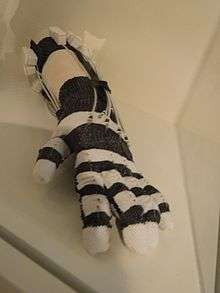Haptic perception
Haptic perception (Greek: haptόs "palpable", haptikόs "suitable for touch") means literally the ability "to grasp something". Perception in this case is achieved through the active exploration of surfaces and objects by a moving subject, as opposed to passive contact by a static subject during tactile perception.[1] The term Haptik was coined by the German Psychologist Max Dessoir in 1892, when suggesting a name for academic research into the sense of touch in the style of that in "acoustics" and "optics".[2][3]
Gibson (1966)[4] defined the haptic system as "[t]he sensibility of the individual to the world adjacent to his body by use of his body". Gibson and others further emphasized what Weber had realized in 1851: the close link between haptic perception and body movement, and that haptic perception is active exploration.
The concept of haptic perception is related to the concept of extended physiological proprioception, according to which when a tool such as a stick is used, perceptual experience is transparently transferred to the end of the tool.
Haptic perception relies on the forces experienced during touch.[5] This research allows the creation of "virtual", illusory haptic shapes with different perceived qualities,[6] which has clear application in haptic technology.[7]
Exploratory procedures
People can rapidly and accurately identify three-dimensional objects by touch.[8] They do so through the use of exploratory procedures, such as moving the fingers over the outer surface of the object or holding the entire object in the hand.[9]
The following exploratory procedures have been identified so far:
- Lateral motion
- Pressure
- Enclosure
- Contour following
Thus gathered object or subject properties are size, weight, contour, surface and material characteristics, consistency and temperature.
Impairments of haptic sensitivity
Haptic sensitivity can be impaired by a multitude of diseases and disorders, predominantly relating to skin injuries (incisions, burns, etc) and nerve lesions (through injury or impaired circulation). Additionally, loss of sensitivity (neuropathy) may be caused by metabolic, toxic and/or immunologic factors. Examples of medical conditions that can cause neuropathies are diabetes mellitus, chronic kidney disease, thyroid dysfunction (hyper- and hypothyroidism) as well as hepatitis, liver cirrhosis and alcohol dependency.
Loss of the sense of touch is a catastrophic deficit that can impair walking and other skilled actions such as holding objects or using tools.
Haptic therapy

Immersive environments can recreate the feeling of haptic interaction.[10] Exoskeletal gloves such as the Exo-Skin Soft Haptic exoskeletal interface, developed at Drexel University, can be programmed to take a patient through a program of physical therapy exercises to retrain muscles and senses.[11]
See also
References
- ↑ Weber, E. H. (1851). Die Lehre vom Tastsinne und Gemeingefühle auf Versuche gegründet. Friedrich Vieweg und Sohn.
- ↑ Dessoir, M. (1892). Über den Hautsinn. Arch. f. Anat. u. Physiol., Physiol. Abt., 175–339.
- ↑ Grunwald, M. & John, M. (2008). German pioneers of research into human haptic perception. In M. Grunwald (Ed.), Human Haptic Perception (pp. 15-39). Basel, Boston, Berlin: Birkhäuser.
- ↑ Gibson, J.J. (1966). The senses considered as perceptual systems. Boston: Houghton Mifflin. ISBN 0-313-23961-4.
- ↑ Robles-De-La-Torre & Hayward. Force Can Overcome Object Geometry In the perception of Shape Through Active Touch. Nature 412 (6845):445-8 (2001).
- ↑ "The Cutting edge of haptics"
- ↑ Robles-De-La-Torre G. Principles of Haptic Perception in Virtual Environments. In Grunwald M (Ed.), Human Haptic Perception, Birkhäuser Verlag, 2008. Archived 2011-07-26 at the Wayback Machine.
- ↑ Klatzky RL, Lederman SJ, Metzger VA (1985). "Identifying objects by touch: An "expert system."". Perception & Psychophysics. 37 (4): 299–302. doi:10.3758/BF03211351.
- ↑ Lederman SJ, Klatzky RL (1987). "Hand movements: A window into haptic object recognition". Cognitive Psychology. 19 (3): 342–368. doi:10.1016/0010-0285(87)90008-9. PMID 3608405.
- ↑ Koerner, Michael; Wait, Eric; Winter, Mark; Bjornsson, Chris; Kokovay, Erzsebet; Wang, Yue; Goderie,, Susan K.; Temple, Sally; Cohen, Andrew R. (August 2014). "Multisensory Interface for 5D Stem Cell Image Volumes". Conf Proc IEEE Eng Med Biol Soc. 2014: 1178–1181. doi:10.1109/EMBC.2014.694380. PMC 4321857. PMID 25570174.
- ↑ Koerner, M.; Fedorczyk, J.; Cohen, A .; Dion, G. "Design and Implementation of the Exo - Skin Soft Robotic Rehabilitation Exoskeleton" (PDF). Drexel University. Retrieved 10 May 2017.
Further reading
- Grunwald, M. (Ed., 2008). Human haptic perception - Basics and Applications. Basel/Boston/Berlin: Birkhaeuser. ISBN 978-3-7643-7611-6
- Lederman, S. J.; Klatzky, R. L. (1990). "Haptic classification of common objects: Knowledge-driven exploration". Cognitive Psychology. 22: 421–459. doi:10.1016/0010-0285(90)90009-s.
- Montagu, A. (1971). Touching: The human significance of the skin. Oxford, England: Columbia U. Press.